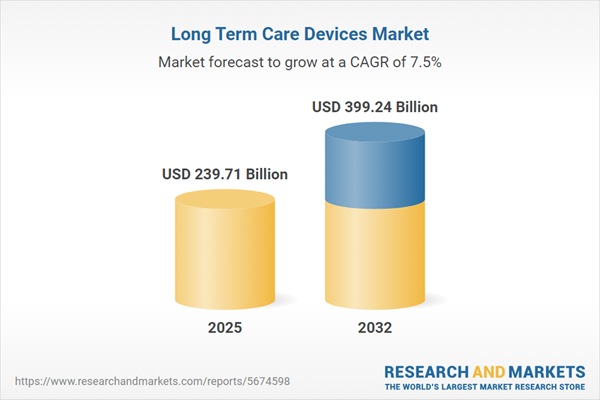Speak directly to the analyst to clarify any post sales queries you may have.
The long term care devices market is reshaping care for aging populations and chronic disease management by delivering advanced solutions that enhance patient independence and optimize care beyond hospital settings. As care models evolve, senior executives face both emerging opportunities and operational complexity, demanding clear insight into sector drivers and strategic approaches.
Market Snapshot: Long Term Care Devices Market Overview
The long term care devices market grew from USD 224.05 billion in 2024 to USD 239.71 billion in 2025. It is projected to advance further at a CAGR of 7.48%, reaching USD 399.24 billion by 2032. Market expansion reflects increasing demand for devices that support patients outside of acute care facilities, leveraging innovations that streamline care delivery, and address resource constraints.
Scope & Segmentation in the Long Term Care Devices Market
This report provides comprehensive coverage of market sub-segments, enabling stakeholders to align investments with the most dynamic areas:
- Product Type: Wearable devices, non-wearable devices
- Device Categories: Diagnostic solutions including blood pressure and glucose monitors, fall detection systems, thermometers, bed alarms, ECG and Holter monitors, and smart wearables for monitoring
- Mobility Assist Technologies: Crutches, canes, walkers, rollators, wheelchairs, and home medical furniture
- Therapeutic Devices: Home dialysis equipment, home IV pumps, home respiratory care, wound care devices, insulin delivery systems, and assistive communication tools
- Distribution Channels: Offline (medical equipment suppliers, pharmacies), online (direct digital marketplaces, telemedicine integration)
- End Users: Assisted living facilities, home care, hospices, nursing homes, hospitals, rehabilitation centers
- Regional Coverage: Americas (United States, Canada, Mexico, Brazil, Argentina, Chile, Colombia, Peru), Europe (UK, Germany, France, Russia, Italy, Spain, Netherlands, Sweden, Poland, Switzerland), Middle East (UAE, Saudi Arabia, Qatar, Turkey, Israel), Africa (South Africa, Nigeria, Egypt, Kenya), Asia-Pacific (China, India, Japan, Australia, South Korea, Indonesia, Thailand, Malaysia, Singapore, Taiwan)
- Leading Companies: Prominent manufacturers, including Abbott Laboratories, B. Braun SE, Medtronic PLC, GE HealthCare, Siemens Healthineers AG, and others studied in detail
Key Takeaways for Senior Decision-Makers
- Technological convergence is elevating devices from static tools to intelligent, data-driven platforms, enabling real-time patient monitoring and proactive interventions.
- Shift towards home-based and remote care is leading manufacturers to prioritize ergonomic design, modularity, and seamless connectivity tailored for non-clinical settings.
- Patient engagement is rising, with intuitive interfaces and enhanced data visibility increasingly critical to product adoption and satisfaction among users and caregivers.
- Regional market strategies must address varied reimbursement structures, regulatory requirements, and supply chain ecosystems to capture growth in each territory.
- Competitive leadership depends on efficient integration between hardware and digital health platforms, as well as rapid response to regulatory shifts and demographic change.
Tariff Impact: United States Policy Shifts
New U.S. tariffs on imported device components and finished products will raise input costs for manufacturers with offshore production, prompting reassessment of sourcing and regional manufacturing strategies. These cost pressures could influence product development priorities and impact accessibility, making proactive supply chain and distribution planning essential for business continuity.
Methodology & Data Sources
This research utilizes a hybrid approach, combining in-depth interviews with industry leaders, healthcare professionals, and end users, alongside structured surveys of distributors and payers. Secondary validation encompasses regulatory filings, clinical publications, and patent analysis to confirm insights and map technological advances. All findings are peer-reviewed by an expert advisory board specializing in market and policy trends.
Why This Report Matters
- Enables strategic allocation of resources by mapping high-growth segments and emerging regional opportunities in the long term care devices market.
- Supports risk management and operational resilience by detailing the impact of new regulatory conditions and tariff scenarios on supply chains.
- Provides actionable intelligence for optimizing product portfolios, partnership development, and patient engagement strategies.
Conclusion
The long term care devices market presents significant opportunities for organizations ready to leverage technology, adapt to shifting demographics, and respond to evolving care models. This report equips senior decision-makers with the insights needed to drive growth, innovation, and operational efficiency in a dynamically changing global landscape.
Additional Product Information:
- Purchase of this report includes 1 year online access with quarterly updates.
- This report can be updated on request. Please contact our Customer Experience team using the Ask a Question widget on our website.
Table of Contents
3. Executive Summary
4. Market Overview
7. Cumulative Impact of Artificial Intelligence 2025
Companies Mentioned
The companies profiled in this Long Term Care Devices market report include:- Abbott Laboratories
- ARKRAY Inc.
- Asahi Kasei Corporation
- B. Braun SE
- Baxter International Inc.
- Becton, Dickinson and Company
- BMC Medical Co., Ltd.
- Boston Scientic Corporation
- Cardinal Health, Inc.
- Compass Health Brands
- Drive DeVilbiss Healthcare
- F. Hoffmann-La Roche Ltd.
- Fresenius Medical Care AG
- GE HealthCare
- Getinge AB
- GF Health Products, Inc.
- Honeywell International Inc.
- Invacare Holdings Corporation
- Johnson & Johnson Services Inc.
- Koninklijke Philips N.V.
- Linde PLC
- Medline Industries, LP
- Medtronic PLC
- Omron Corporation
- PHC Holdings Corporation
- ResMed Inc.
- Siemens Healthineers AG
- Solventum
- Sunrise Medical LLC
- Vayyar Care
Table Information
| Report Attribute | Details |
|---|---|
| No. of Pages | 196 |
| Published | November 2025 |
| Forecast Period | 2025 - 2032 |
| Estimated Market Value ( USD | $ 239.71 Billion |
| Forecasted Market Value ( USD | $ 399.24 Billion |
| Compound Annual Growth Rate | 7.4% |
| Regions Covered | Global |
| No. of Companies Mentioned | 31 |









